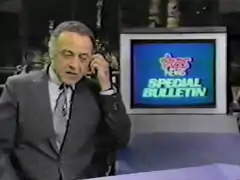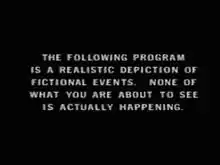Special Bulletin
Special Bulletin is a 1983 American made-for-television film. It was an early collaboration between director Edward Zwick and writer Marshall Herskovitz, a team that would later produce such series as thirtysomething and My So-Called Life. The movie was first broadcast March 20, 1983 on NBC as an edition of NBC Sunday Night at the Movies.[1][2]
| Special Bulletin | |
|---|---|
 Ed Flanders as RBS anchor John Woodley. | |
| Genre | Drama Docufiction |
| Written by | Marshall Herskovitz (teleplay) Edward Zwick Marshall Herskovitz (story) |
| Directed by | Edward Zwick |
| Starring | Ed Flanders |
| Theme music composer | Ferdinand Jay Smith (promo and news music only) |
| Country of origin | United States |
| Original language | English |
| Production | |
| Executive producer | Don Ohlmeyer |
| Producers | Marshall Herskovitz Edward Zwick Lynn D. Baltimore (associate producer) |
| Editor | Arden Rynew |
| Running time | 105 minutes |
| Production company | Ohlmeyer Communications Company |
| Distributor | NBC |
| Release | |
| Original network | NBC |
| Original release | March 20, 1983 |
In this movie, a terrorist group brings a homemade atomic bomb aboard a tugboat in the harbor of Charleston, South Carolina in order to blackmail the U.S. Government into disabling its nuclear weapons, and the incident is caught live on television. The movie simulates a series of live news broadcasts on the fictional RBS Network.[1][2]
Synopsis
A “Special Bulletin” slide interrupts commercials for the fictional RBS television network, leading to an emergency newscast hosted by Susan Myles and John Woodley. In Charleston, South Carolina, reporter Steve Levitt and his cameraman are caught in a firefight between the U.S. Coast Guard and a group of terrorists on a tugboat. Overwhelmed, the coast guards surrender, and they, along with the camera crew, are taken hostage onboard the tugboat.
The leader of the terrorists, Dr. Bruce Lyman, addresses Woodley and Myles, promising to release the coast guards in exchange for RBS to broadcast his demands. Lyman and his group demand that every nuclear trigger device from the local naval base be delivered to them. Otherwise, they will detonate a homemade nuclear bomb on their ship within twenty-four hours. Dr. Lyman explains that their actions are to bring about worldwide disarmament, and the response from the U.S. Government will decide whether or not they value war over their own people.
Investigations reveal Dr. Lyman used to design nuclear weapons for the government, but became disillusioned, and turned to anti-nuclear campaigning. The other terrorists are identified, including Dr. David McKeeson, a nuclear scientist who built the group’s bomb; Jim Sever, an emotionally unstable bank robber; Frieda Barton, a poet and anti-war activist implicated in a bombing; and Diane Silverman, a social worker and Lyman’s friend.
The government ignores and belittles the threat, prompting Dr. McKeeson to show the nuclear device to Levitt and his cameraman, explaining he is the only person who can disarm it. Public evacuations of Charleston are called, but the residents, convinced the terrorists are bluffing, initially ignore them until confirmation is made that the device is real, which sparks panic. The terrorists begin to grow desperate, only for a Department of Defense official to announce the following evening that they will agree to the group’s demands. A van arrives outside the tugboat, allegedly carrying the nuclear triggers.
However, the television on the tugboat cuts off, hiding from the terrorists an approaching squad of Delta Force commandos. The commandos storm the tugboat and kill all the terrorists but Barton, who is caught and arrested, and McKeeson, who commits suicide. The news crew is unharmed and evacuated from the boat. Though the RBS studio celebrates, Woodley is disturbed by the government’s deception.
While the anchors speak with a nuclear expert, members of the Nuclear Emergency Search Team board the boat to disarm the bomb with mere minutes left to do so, but the engineers accidentally trigger a hidden safeguard on the device and frantically try to stabilize the bomb. One member panics and tries fleeing the tugboat. Suddenly, static fills the broadcast as the studio loses contact with Charleston.
The alarmed Woodley and Myles eventually manage to make contact with reporter Meg Barclay, who was on USS Yorktown, two miles away from the tugboat. Her surviving cameraman plays back footage recorded minutes earlier, revealing the nuclear bomb detonated, depicting a rising mushroom cloud on the horizon. Meg breaks down, asking if she will die from radiation. Woodley and Myles break down on air, rendered speechless by Charleston’s devastation. Woodley emotionally asks if anything can be done to help their colleagues and Charleston’s civilians.
Three days later, Myles reports on the aftermath of the detonation. Thanks to the evacuation order, only around 2,000 civilians perished, but with many injuries. Half a million people were left homeless by the devastation, and Charleston will remain uninhabitable for many years. The final scene ends as the broadcast begins reporting on other news in the world.
Cast
| Actor | Role |
|---|---|
| Ed Flanders | John Woodley (RBS Anchor) |
| Kathryn Walker | Susan Myles (RBS Anchor) |
| Christopher Allport | Steven Levitt (WPIV reporter) |
| David Clennon | Dr. Bruce Lyman (Terrorist) |
| Rosalind Cash | Frieda Barton (Terrorist) |
| Roxanne Hart | Megan "Meg" Barclay (RBS Reporter) |
| David Rasche | Dr. David McKeeson (Terrorist) |
| Lane Smith | Morton Sanders (RBS Reporter) |
| Ebbe Roe Smith | Jim Seaver (Terrorist) |
| Roberta Maxwell | Diane Silverman (Terrorist) |
| J. Wesley Huston | Bernard Frost (WPIV) |
| William A. Gamble, Jr. | Special Forces Commander |
Impact

Several factors enhanced Special Bulletin's resemblance to an actual live news broadcast. The movie was shot on videotape rather than film, which gave the presentation the visual appearance of being "live". Other small touches, such as actors hesitating or stumbling over dialogue (as if being spoken extemporaneously) and small technical glitches (as would often be experienced in a live broadcast), contributed to the realism. With the exception of RBS network and news jingles, there is also no musical score used. The end credits are accompanied by the sound of a teletype.[1][2]
In addition, some specific references made the movie especially realistic to residents of Charleston. The call letters of the fictional Charleston RBS affiliate, WPIV, were close to those of NBC's then-affiliate in Charleston, WCIV. Also, a key plot element mentions "a power failure at a transmitter in North Charleston"; the TV transmitter sites are actually in Awendaw.[1][2]
The filmmakers were required to include on-screen disclaimers at the beginning and end of every commercial break in order to assure viewers that the events were a dramatization. The word "dramatization" also appeared on the screen during key moments of the original broadcast. Additionally, WCIV placed the word "Fiction" on screen at all times during its showing of the movie. The film also made use of "accelerated time"—events said to take place hours apart instead are shown only minutes apart. Nonetheless, there were still news reports of isolated panic in Charleston. Much as with the famous 1938 radio broadcast of The War of the Worlds, it was entirely possible for viewers to tune in between disclaimers and make a snap judgment about what they were seeing, although in both cases a quick flip of the dial would reveal that no other stations were covering this supposedly major news event. When the program was rebroadcast in 1984, the only disclaimers were made at the commercial breaks; there were none on the screen while the action was taking place.[3][4]
Reaction
Special Bulletin was nominated for six Emmy awards and won four, including Outstanding Drama Special. It also won Directors Guild of America and Writers Guild of America prizes for Zwick and Herskovitz, as well as the Humanitas Prize, which irked former NBC president Reuven Frank. In his book on TV news, Out of Thin Air, Frank called Special Bulletin "junk" and claimed he wanted to return his own Humanitas Prize in protest, "but I couldn't find it."[5][6]
Leonard Maltin's Movie and Video Guide rated Special Bulletin "way above average."[7]
The Washington Post described it as “A shrewd, keen, wise, hip, occasionally lacerating and sometimes gravely funny dark parody of network TV news coverage.” Also, “At times, the unfolding story in Special Bulletin comes across as ludicrous, but then one has to think, how much more ludicrous is it than some of the actual news events of the past 15 years or so, and the way television has honed its way of covering them? It’s a process that deserves scrutiny not just in poker-faced journals and ivory tower think tanks but on television. Praiseworthy trailblazers like the ABC News late night Viewpoint broadcasts have done this one way. Special Bulletin does it in another way-not a better one, perhaps, but in one more accessible to greater numbers of viewers.”[2]
The New York Times stated that 2,200 calls from alarmed viewers were received in New York, Chicago, Los Angeles, Washington and Cleveland. The WNBC-TV station in New York received 731 calls, 44 of them critical, and 43 asking if the program was real. The station manager of WCIV-TV in Charleston, Celia Shaw, said, “In retrospect, maybe it would have been better with a theoretical city, rather than Charleston, with its large number of military installations.”[8]
Home video
Lorimar Home Video issued Special Bulletin on VHS and Betamax, and Warner Home Video would later reissue it; these releases omit the on-screen "dramatization" overlay. Starting in January 2010, Warner Bros. made the film available on DVD for one year as part of its Warner Archive Collection. Warner's rights have since reverted to the production company and the DVD is currently out of print.[9]
See also
- Countdown to Looking Glass, a 1984 Canadian TV movie that used simulated news broadcasts to chronicle a Cold War showdown between the United States and the Soviet Union.
- Without Warning, an apocalyptic 1994 TV movie also presented as a faux news broadcast.
- The Day After, a 1983 made-for-TV movie about a nuclear war and its effects on the Midwest US.
References
- Rogers, Chris (September 11, 2012). "Thousand Words: "We interrupt this programme…" Reality television: Special Bulletin (Edward Zwick, 1983)". The Big Picture.
- Shales, Tom (March 20, 1983). "Bulletin! The Show That Shook NBC". The Washington Post.
- Stracener, William (April 30, 1984). "The repeat showing of the television movie "Special Bulletin"". United Press International.
- El-Miskin, Tijani (March 1989). "Special Bulletin-Transfictional disavowal". Jump Cut. 34: 72–76.
- "Special Bulletin-Awards & Nominations". Emmys-Television Academy. 2020.
- Frank, Reuven, 1920-2006. (1991). Out of thin air : the brief wonderful life of network news. New York: Simon & Schuster. ISBN 0-671-67758-6. OCLC 23461999.CS1 maint: multiple names: authors list (link)
- Klein, Andy (November 5, 1998). "Final Jeopardy". Miami New Times.
- Bedell, Sally (March 22, 1983). "NBC Nuclear-Terror Show Criticized". The New York Times.
- "Widescreen Wonders." Warner Archive Podcast, 12-9-14